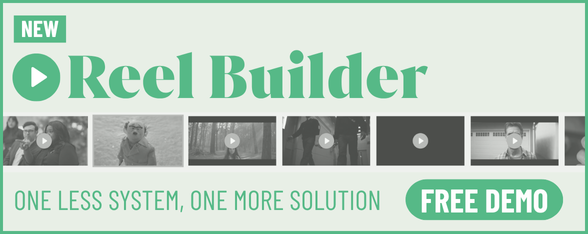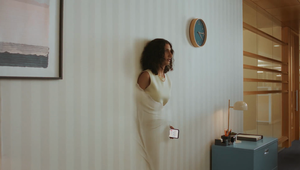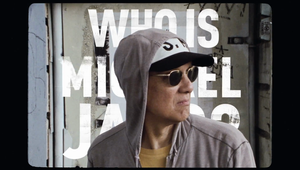
The Directors: Andrew Batista

Andrew is a director based in Los Angeles. He’s always looking to push his craft and find new ways to tell emotionally powerful stories and create visually memorable work. He got his start directing local commercials, short films, and documentaries – often directing and DP’ing. Andrew’s had the pleasure of directing spots for clients, including Atlassian, US Army, Nike, Lyft, Audi, Ford, Meta, Pfizer and Square.
Name: Andrew Batista
Location: Los Angeles
Repped by/in: Strike Anywhere, US
Awards:
Vimeo Best of the Year Nomination 2020 - America, As In US
Vimeo Staff Pick - America, As In Us
2017 YDA Shortlist - Chasing the Wind
Vimeo Staff Pick - Chasing the Wind
LBB> What elements of a script sets one apart from the other and what sort of scripts get you excited to shoot them?
Andrew> This is a tough one because I like a lot of things. But if I had to boil it down, I like it when something is unpredictable and has a bit of mystery and wonder - it feels closer to how life feels. I think it's related to film being a kind of magic trick. It keeps me engaged.
I’m also in love with the process of filmmaking. Anytime there’s a challenging sequence or shot, I get pretty excited trying to figure out how we will pull it off. It doesn’t have to be technically difficult, either. It could be simple in terms of camera work and the edit, but difficult to arrive at emotionally. Some of my favourite films are the ones that leave me with a feeling I can’t shake.
Probably the most important thing, though, is that I want the script to resonate with me. I want to feel the truth of what it’s saying. If I can’t connect with the sentiment, it’s probably not a good fit.
LBB> How do you approach creating a treatment for a spot?
Andrew> Projects are usually in motion long before I enter the picture, and there's already been a lot of work that's gone into the creative by the time I'm on board. So, I often listen and ask questions about where the agency and brand have been and where they hope to go. I want to make sure we're all rowing in the same direction.
From there, I'll start by putting my thoughts on paper to help myself articulate what's in my head (and anyone who might end up reading the treatment). The more details, the better because it is kind of a discovery process and helps me see an idea more clearly. This becomes the foundation of the treatment.
At the same time, I'm usually doing research - looking for inspiration to see what sparks. It's helpful to see what kind of work has already been done for the brand or the genre. I keep what I like and/or eliminate what I don't. And if there's a way to do something in an unexpected way, that's usually the most interesting approach.
LBB> If the script is for a brand that you're not familiar with/ don’t have a big affinity with or a market you're new to, how important is it for you to do research and understand that strategic and contextual side of the ad? If it’s important to you, how do you do it?
Andrew> Research is incredibly important, no matter the project. I want to learn where the brand has been, if they have a specific tone or voice, and what their core values are. Is there flexibility in tone? Is there room to take it in a new direction?
It’s also important to learn about the product. What is it? What does it do? Would I use it? I want to know the basics. I’m asking the same questions the audience will ask. From there, it’s a conversation with the agency team and fellow creatives to get the inside track. The more I can be on the same page as the creative team, the better. That’s the foundation. Once that’s established, we can talk creatively.
LBB> For you, what is the most important working relationship for a director to have with another person in making an ad? And why?
Andrew> It takes a village. I couldn’t do anything without my team, crew, agency, or the brand. Everyone has their job, and we’re all working together toward creating this thing.
LBB> What type of work are you most passionate about - is there a particular genre or subject matter or style you are most drawn to?
Andrew> I don’t know if it’s a genre, but I like projects that feel planted in their own world and don’t necessarily feel like “advertising.” It’s the perfect blend of storytelling and brand. I’m thinking about Glazer’s Guinness Surfer Spot or Fincher’s Gap campaign - they exist in their own world while simultaneously highlighting the spirit of the brand. It really is its own art form. I’d love to be creating work at that level.
LBB> What misconception about you or your work do you most often encounter and why is it wrong?
Andrew> I’m often being looked at for docu-style projects, which I love. They’re great because there are a thousand ways to tell those stories. However, my instincts are narrative-leaning, and I don’t want to ignore that. I also love the process of narrative projects - directing actors, designing sets, lighting design, etc. It’s a whole other way of working, and I’m actively pursuing that work.
LBB> What’s the craziest problem you’ve come across in the course of a production – and how did you solve it?
Andrew> Production is always a bit of a circus. We try hard for it not to be, but it’s also part of the magic. You have a bunch of very different people, often in crazy locations, trying to capture something special on camera. There’s no place I’d rather be.
One of the craziest problems I encountered on a shoot was when we were shooting a windsurfing film down in Mexico during a wind drought. The town we were filming in is known for having constant wind - it was certainly that way when we scouted it. However, there was zero wind when we showed up with our crew to shoot. Just a very light ocean breeze. Great if you want to sit on the beach. Awful if you want to windsurf. Other surfers were walking around town, talking about how crazy it was and how they had never seen anything like it.
We spent a bunch of money to fly a crew and gear to a remote little area, and the clock was ticking. I had no idea how to shoot a windsurfing film without wind.
We decided to do what we could and keep it moving. We shot whatever didn’t rely on windy conditions. We were tracking the weather almost hourly at this point. With our backs against the wall, having shot all we could on land, we decided to jump in the boat and literally chase the wind. We’d see the white caps off in the distance - a sign that the wind was breaking the crest of the waves - and Jesper, our windsurfer, would say, let’s try it over there and see if I can catch some speed. Little by little, we were piecing it together. It was like a hunt for wind. After a few days on the water, we shot enough footage for the project. I came home with a few years of my life shaved off, some incredible stories, and a hard drive filled with beautiful footage.
LBB> How do you strike the balance between being open/collaborative with the agency and brand client while also protecting the idea?
Andrew> I think it starts with building trust between the creatives, the brand, and myself. Earning that trust usually comes with listening to both the agency and brand from day one. From the first call to the treatment and every step along the way, we're building trust together, which in turn opens the door to more creativity. They need to know that I'm there as a partner and collaborator who wants to tell the best story.
LBB> What are your thoughts on opening up the production world to a more diverse pool of talent? Are you open to mentoring and apprenticeships on set?
Andrew> Easy. The more variety of voices and ideas in the space, the better. Everyone wins.
I’ve encountered many gatekeepers throughout my career - people who boxed me out or made me feel small or not worthy. On the flip side, I’ve had several great people help me with advice, an opportunity, or an introduction. The difference is that the people who were gracious with their time and shared their experiences seemed to just be living better. They walked lighter. I think there’s something to that.
Even though I battle whether I’m even “good enough” yet, I’d love to mentor. It’d be a privilege, really. I love the craft so much that it would probably be more fun for me than the mentee.
LBB> How do you feel the pandemic is going to influence the way you work into the longer term? Have you picked up new habits that you feel will stick around for a long time?
Andrew> I’m not really sure. I know the pandemic pushed pause on the world, which gave me time to ground myself. It gave me an opportunity to take stock of my work and relationships and reflect on who I was as a filmmaker. My biggest takeaway was that I want to be on set with people who enjoy the process as much as I do.
LBB> Your work is now presented in so many different formats - to what extent do you keep each in mind while you're working (and, equally, to what degree is it possible to do so)?
Andrew> You try your best.
LBB> What’s your relationship with new technology and, if at all, how do you incorporate future-facing tech into your work (e.g. virtual production, interactive storytelling, AI/data-driven visuals etc)?
Andrew> I think we’re living in incredible times.
Generally, I think there’s a lot of fear around new tech, especially AI. But I think it’ll be just one of the many tools we use to create and tell stories. For the most part, we’re trending toward doing way more with less. A small team of people will be able to create something that required hundreds of people to do just a few years ago. It’ll go a long way toward further democratising the process and opening the door to more unique voices and filmmakers, which is a huge plus.
Personally, I’ve used ChatGPT and Midjourney in the ideation phase of a project or treatment to put a few thoughts on the board. As tools, they can speed up the process and help you get out of your head or see things more clearly. As a result, they can help communicate your vision for a project. However, it hasn’t become “a part of my process.” I’m more inspired by human-made music, books, and photography. There’s something to the fact that another human created a piece of music, a photograph, or whatever inspires and challenges me. What it takes to create something will always be interesting to me. The best art is dripping with the love and emotion the artist put into it. I think we inherently recognize that and respond to it. The further we remove the art from that process, the more sterile it becomes.
LBB> Which pieces of work do you feel really show off what you do best – and why?
Andrew>
Chasing the Wind
This film is one of my favourites that I’ve done. Not only was it a miracle to pull off (see the above story about the wind), but I often point to it as a reflection of my taste and what I’d like to make more of. I loved the images we got, the score James Everingham made for it is something I still listen to, and the story is one that is universal.
Nine Numbers
This film is special because it gave us an opportunity to look at an issue so often viewed through a black-and-white lens. Cesar’s story gave us a face and added nuance to the discussion of what it means to be an American, an immigrant, and, in this case, a Christian. His story challenges any preconceived ideas one might have and exists in a grey zone where the right thing slowly emerges. As a son of an immigrant, this one hit particularly hard. It was also a blast to film in black and white and treat it like an old film - a subtle way of disarming audiences.
Atlassian + AHA
I really like where this piece ended up and how it balances a very emotional story, a customer story, and a branded film without feeling forced. All the pieces fit together naturally. It took everyone working together to get it there, but we stuck the landing.
Riverhounds
I really loved filming my hometown of Pittsburgh the way I see it - a cool and gritty town loaded with texture and spirit. It’s also special because of how we made it. The budget was tight, but we had a lot of flexibility creatively, so we shot pretty run and gun with a small crew. The result is a little film that mirrors the down-and-dirty way in which we shot it. It feels like the same hustle and grind that is Pittsburgh.















